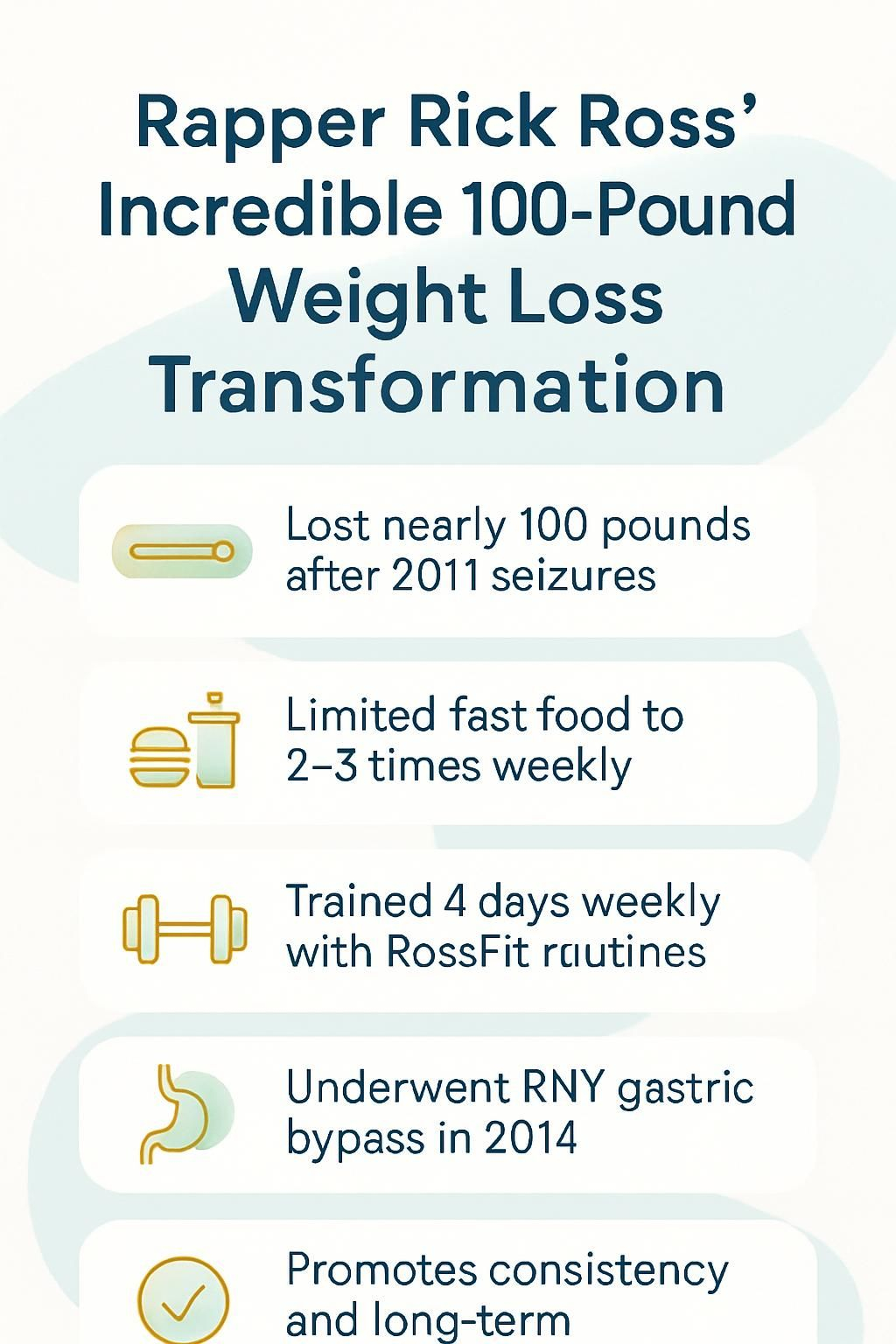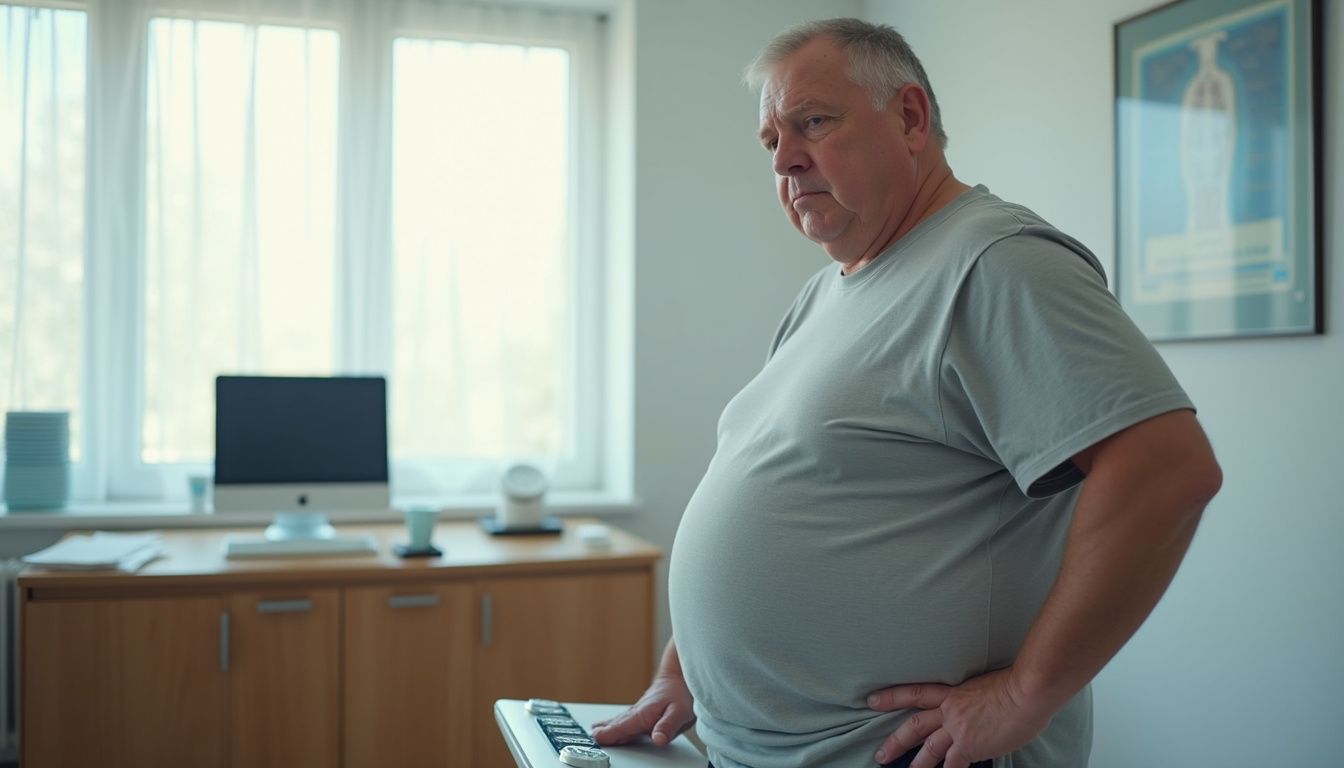Rapper Rick Ross’ Incredible 100-Pound Weight Loss Transformation
Our Nutrition Assistant AI Suite will transform your body. You will lose fat, get toned, and build muscle. Gain confidence and optimal health.
If losing weight feels hard, the Rick Ross weight loss story offers a clear path. After two serious seizures, the rapper Rick Ross reshaped his routine and dropped almost 100 pounds. His method blends realistic food choices, steady exercise, and better sleep, all built for long-term health.
In this guide, you will see what pushed him to act, how he changed his diet and workouts, and the simple habits that helped him keep the weight off. You can use the same ideas to build your own plan, one step at a time.
Key Takeaways
- Rick Ross lost nearly 100 pounds after two seizures in 2011, which forced urgent changes to his diet, sleep, and exercise.
- He followed a structured meal plan with a chef, limited fast food to two or three times a week, and cut sugary drinks like root beer.
- Ross built “RossFit,” a CrossFit-style routine, training four days a week with cardio and strength moves for steady progress.
- Reports note an RNY gastric bypass in 2014 after a failed lap band attempt, which, along with lifestyle changes, supported major weight loss.
- He promotes long-term habits over fad diets, focusing on consistency, meal planning, stress control, and adequate sleep.

What health issues prompted Rick Ross to change?

Major health scares forced a rethink. Doctor visits and emergencies made the risks real, so change could not wait.
What health scare did Rick Ross experience?
In 2011, the Miami-raised artist William Leonard Roberts II, known as Rick Ross, experienced two seizures within six hours. Each episode was serious enough to cause an emergency landing of his private jet.
At the time, his weight neared 350 pounds. His routine included 24-ounce steaks at 4 a.m. and only three hours of sleep per night. Doctors warned that these habits were pushing his body to the edge.
“I was eating big meals at all hours and sleeping just a few hours a night. The seizures really scared me. I knew I had to change,” Ross told a health magazine.
What warnings did his doctor give him?
His medical team told him to lose weight to protect his life. They urged him to move fast, reduce fast food, and make exercise part of his week. He also received guidance to seek expert nutrition support instead of chasing fad diets that fade.
Because his obesity was severe, bariatric options were discussed. Hearing the risks clearly helped him change both food choices and fitness. Those steps formed the base for his 100-pound weight loss plan.
How did Rick Ross lose 100 pounds?
Rick Ross lost 100 lbs by reshaping daily habits. He focused on choices he could repeat, even during travel and studio work.
What changes did Rick Ross make to his diet?
He worked with a chef to plan meals that tasted good and fit his goals. Portions became smaller and smarter. Fast food from places like Checkers and Wingstop was limited to two or three days each week, only between noon and 5 p.m.
This structure helped rein in calories. Planning also curbed late-night snacking and sugary drinks, including the habit of downing eight root beers in one sitting. Instead of quick fixes, he chose a sustainable plan that fit an artist’s schedule.
“I just made up my mind that I had to do better,” Ross said in Men’s Health, explaining how he shifted from crash diets to consistent healthy eating.
Which unhealthy foods did Rick Ross cut out?
Several high-calorie favorites were dropped or reduced. He stopped the pattern of two 4-ounce steaks daily and those giant 24-ounce steaks at 4 a.m. Fast food shifted from a daily default to twice a week. Sugary drinks, especially root beer, were cut out.
He moved away from processed snacks and heavy red meat. Replacing soda and fried foods helps control calories and supports workouts. I noticed the same effect after dropping soda, my energy stayed steadier during gym sessions.
Cutting back on sugar and ultra-processed foods can improve energy and appetite control. That change supports progress whether you follow a CrossFit program, a “RossFit” style circuit, or another training plan.
What healthy foods did Rick Ross add to his meals?
After removing fried and sugary items, he added more whole foods. Plates centered on lean protein, leafy greens, and colorful fruits. High-fiber choices like pears and whole grains helped him feel full and fueled workouts.
He and his personal chef focused on meals that were both healthy and enjoyable. Balanced plates kept hunger in check for training four days a week. You can do the same with simple swaps like grilled chicken salads or fruit for dessert.
How did Rick Ross build his fitness routine?
Ross created a custom plan called “RossFit.” It borrows from CrossFit but stays flexible, so workouts stay short and engaging.
What is Rick Ross’ “RossFit” workout?
RossFit is a personal circuit routine he built after his health scare. Inspired by CrossFit, the goal is to keep you moving with variety and pace.
Four days per week, you warm up with a jog. Then you rotate through five stations, including moves like deadlifts and pushups. Sessions last about 30 minutes, targeting fat loss and strength.
He stuck with this approach for months because it felt doable and fun. The aim is not becoming a pro athlete, it is building a habit you can repeat.
How often does Rick Ross exercise each week?
His schedule includes four workouts each week. A short jog warms up the body on training days. Working out with friends often adds a social boost and accountability.
The weekly mix pairs cardio and strength so progress stays balanced. Rest days protect recovery. This steady rhythm helped him build a slimmer, healthier frame after losing more than 100 pounds.
What types of exercises are included in his workouts?
RossFit blends strength and cardio in a rotating circuit. Across five stations in 30 minutes, you might perform:
- Deadlifts or kettlebell swings for lower-body power
- Push-ups for chest and shoulder strength
- Rows or resistance-band pulls for the back
- Jogging or jump rope for heart health
- Functional moves, such as squats and farmer carries, to help daily movement
Switching stations fights boredom and plateaus. Variety keeps you engaged and builds total-body fitness. I found that rotating stations kept me more consistent than lifting or running alone.
What lifestyle changes help Rick Ross maintain his weight loss?
The right habits outside the gym make results stick. Stress control, solid sleep, and regular meal planning keep momentum going.
How does Rick Ross manage stress and sleep?
He once slept only three hours a night. Doctors warned that poor sleep can raise health risks and trigger cravings. He began aiming for seven to eight hours nightly.
Better sleep supports recovery, mental health, and stable energy. Stress management matters as much. Healthier routines replaced emotional eating triggers and late-night grazing.
When stress is lower and sleep is better, it is easier to follow a plan. The Centers for Disease Control and Prevention notes that most adults should target 7 to 9 hours of sleep for health and performance.
How does meal planning support his discipline?
Meal planning turns good intentions into daily action. With a chef, he set a menu that fit his taste and goals. You can do the same with simple recipes you enjoy.
Limiting fast food to two or three times a week, only between noon and 5 p.m., creates boundaries you can keep. Planning ahead supports consistent nutrition and portion control.
Set meal times and repeatable choices reduce decision fatigue. That makes it easier to hit your targets and support your training plan.
Why does Rick Ross avoid crash diets?
Crash diets promise fast results, but they rarely last. They can slow metabolism and trigger rebound weight gain. Rick Ross chose slow, steady changes with his RossFit routine and planned meals.
This patient approach made healthy eating feel normal instead of a punishment. Progress felt real because it could be maintained week after week.
Did Rick Ross undergo weight loss surgery?
Many fans ask whether surgery helped his transformation. Exercise and diet did a lot of the work, but reports suggest surgery also played a role.
What are the rumors about bariatric surgery?
Some headlines claim the change came only from the gym. Other reports state he had RNY gastric bypass in 2014 after a failed lap band two years earlier.
Gastric bypass reduces stomach size and changes the path of the small intestine. This limits how much you can eat and how you absorb calories. After surgery, he reportedly could eat only a few wings at a time.
Typical outcomes for surgery patients include:
- RNY gastric bypass: about 60 to 70 percent of excess weight lost in one year
- Adjustable gastric band: about 30 to 40 percent of excess weight lost, with higher failure rates
These figures come from summaries by the American Society for Metabolic and Bariatric Surgery. For major obesity, surgery can help, but lifestyle still matters for long-term results.
Evidence suggests surgery supported his progress, while daily habits helped him maintain it.
How does Rick Ross approach natural weight loss?
His day-to-day plan focuses on practical choices. He keeps fast food to set days and tighter time windows, trims portions, and plans meals he enjoys.
Regular exercise remains central. The RossFit routine blends cardio and strength to protect muscle and manage weight. That mix supports energy for touring and studio work.
Even if surgery helps someone start, the lifestyle carries the finish. He shows how structure, consistency, and good sleep make results last.
How has weight loss affected Rick Ross’ life?
Healthier habits changed daily life, from focus at work to confidence in public. Progress built momentum.
How has his health improved after losing weight?
After dropping more than 100 pounds, he reported fewer health issues. The dangerous seizures that once disrupted travel stopped occurring.
At his heaviest, estimates put his BMI near 51 at more than 400 pounds. With weight closer to 300 pounds, that estimate drops to around 38. While BMI is imperfect, the change signals lower risk.
Cutting eight sugary sodas per day helped stabilize blood sugar and reduced empty calories. New routines lowered the chance of urgent medical issues that had sent him to the hospital before.
What changes has Rick Ross noticed in his energy and focus?
Better nutrition and sleep improved his energy and attention. Long studio days and business meetings felt easier to handle.
Training began to feel less like a chore and more like a routine win. As muscle built, confidence grew. That boost supported both creative work and family life.
How is Rick Ross inspiring fans to be healthier?
He shares his story in interviews and on social platforms. The message is simple, skip crash diets and build habits you can repeat.
Fans see a real-life example of consistency paying off. He also talks openly about getting help, including surgery, which reduces stigma for those considering medical support.
Small wins matter. Celebrating progress helps you stay the course, even when life gets busy.
What lessons can we learn from Rick Ross’ transformation?
His journey shows that steady effort beats short bursts. You can adapt these ideas to your own life.
Why is consistency important for weight loss?
Routines make results repeatable. Regular workouts and planned meals build momentum. Quick fixes fade, but daily habits stick.
Research shows that people with consistent eating and exercise patterns have better long-term weight control. I stopped bouncing between fad diets and finally lost weight after sticking to a simple plan.
How do small changes lead to lasting results?
Reduce fast food to twice a week. Shrink portions slightly. Swap root beer for water or unsweetened tea. These changes seem minor, yet they cut a lot of calories across a month.
Make one change at a time to avoid burnout. Improve sleep, then adjust snacks, then add a short walk. Each step builds confidence and results.
How can you find a routine that works for you?
Test different workouts until something fits. Rick Ross built “RossFit” to match his schedule and taste. You can create your own circuit with moves you enjoy.
Try training with friends for motivation. Plan meals that fit your day and budget. Keep some flexibility so you do not feel trapped by the plan.
Personalization made a big difference in Ross’ weight loss. Focus on what keeps you consistent rather than copying someone else’s plan exactly. Next, learn whether Rick Ross used surgery during his transformation journey.
Conclusion
Rick Ross’ weight loss shows what steady change can do. Listening to doctors, adjusting your diet, and training on a regular schedule helped him lose nearly 100 pounds and protect his health. Reports of gastric bypass surgery suggest medical support also played a role, yet his daily habits kept the results going.
You can start small today. Plan simple meals, move your body for 30 minutes, and aim for seven to eight hours of sleep. These steps add up. For medical conditions, or if you are considering bariatric surgery, talk with a qualified healthcare professional for personal guidance.
FAQs
1. How did Rick Ross achieve his 100-pound weight loss transformation?
Rick Ross lost 100 pounds through a combination of regular exercise, healthier eating habits, and medical guidance. He focused on portion control, reduced processed foods, and increased his intake of fruits and vegetables. He also incorporated daily walks and strength training into his routine. According to interviews, he worked closely with health professionals to ensure safe progress.
2. What specific changes did Rick Ross make to his diet and lifestyle?
Rick Ross replaced high-calorie foods with lean proteins, whole grains, and fresh produce. He limited sugary drinks and fast food. He also adopted a consistent sleep schedule and managed stress levels. These changes helped him maintain energy while losing weight.
3. Are there any statistics or data supporting Rick Ross’ weight loss methods?
Studies show that combining regular physical activity with balanced nutrition can lead to significant weight loss. For example, the Centers for Disease Control and Prevention (CDC) states that losing 1-2 pounds per week through healthy eating and exercise is both safe and effective [1]. Rick Ross’ approach aligns with these guidelines.
4. What lessons can others learn from Rick Ross’ personal experience?
Rick Ross’ journey shows that gradual changes in daily habits can produce lasting results. His story highlights the importance of professional support, realistic goals, and persistence. Many people find inspiration in his commitment to health after facing serious medical issues.
Summary:
Rick Ross’ transformation involved exercise, improved nutrition, medical advice, and steady progress. Research supports these strategies as effective for long-term weight management.
[1] Centers for Disease Control and Prevention (CDC). “Losing Weight.” https://www.cdc.gov/healthyweight/losing_weight/index.html







